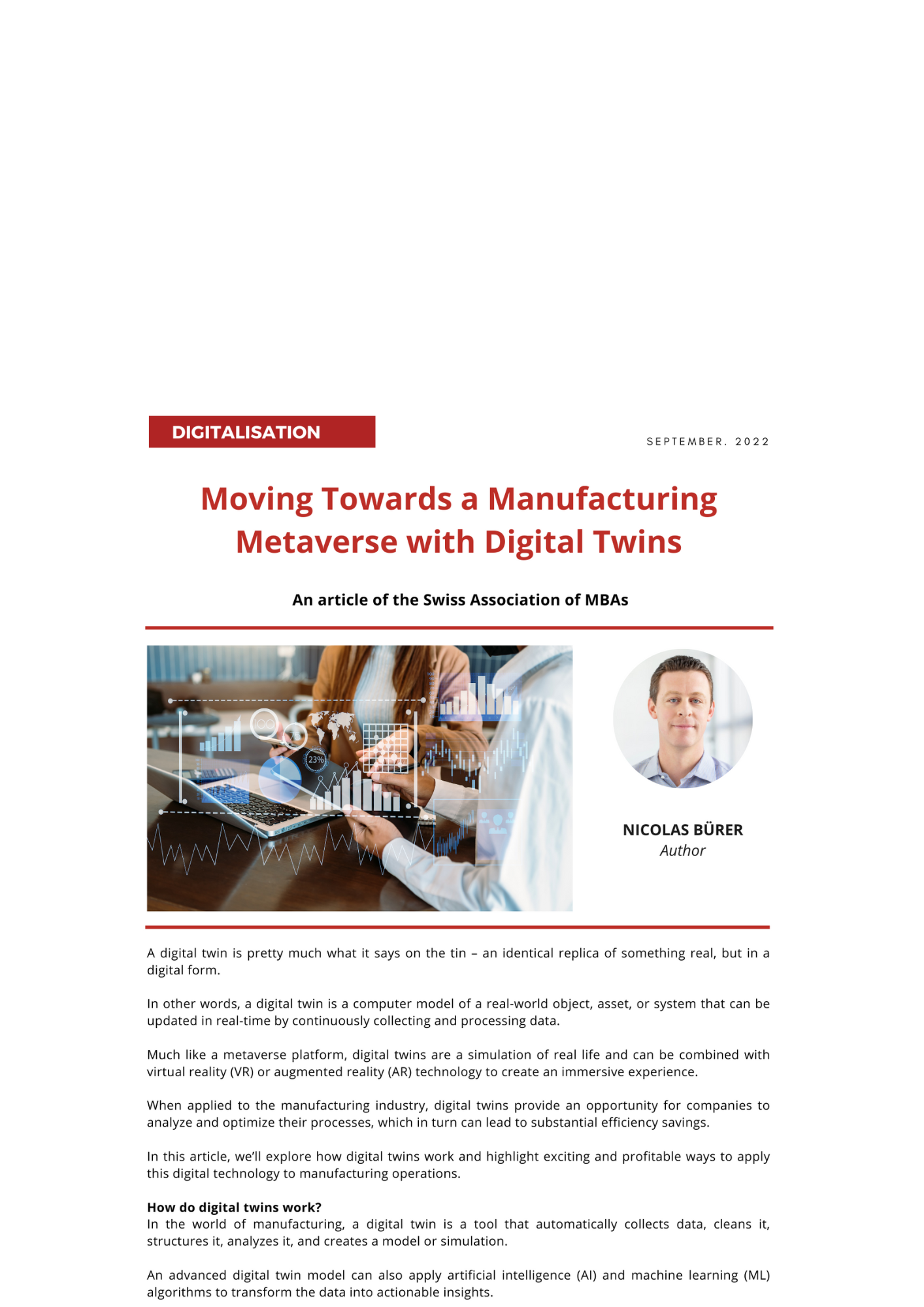
A digital twin is pretty much what it says on the tin – an identical replica of something real, but in a digital form.
In other words, a digital twin is a computer model of a real-world object, asset, or system that can be updated in real-time by continuously collecting and processing data.
Much like a metaverse platform, digital twins are a simulation of real life and can be combined with virtual reality (VR) or augmented reality (AR) technology to create an immersive experience.
When applied to the manufacturing industry, digital twins provide an opportunity for companies to analyze and optimize their processes, which in turn can lead to substantial efficiency savings.
In this article, we’ll explore how digital twins work and highlight exciting and profitable ways to apply this digital technology to manufacturing operations.
How do digital twins work?
In the world of manufacturing, a digital twin is a tool that automatically collects data, cleans it, structures it, analyzes it, and creates a model or simulation.
An advanced digital twin model can also apply artificial intelligence (AI) and machine learning (ML) algorithms to transform the data into actionable insights.
A digital twin model can be constructed to replicate any part or section of an overall manufacturing operation – a process, a system, a machine, or a product. Digital twins enable manufacturers to see a complete digital footprint of their operations from product design and development to the production cycle and distribution.
For example, a digital twin can be used to collect data from IoT sensors that measure the flow of materials on a production line. The data can be analyzed and used to create a simulation of the material flow. Activities within the simulated model can then be adjusted to see the effect on timings and productivity.
Benefits of using digital twins in manufacturing
The main advantages of applying a digital twin model in manufacturing are as follows:
- Capacity increase – In-depth and accurate analysis of a production line can identify bottlenecks and automatically suggest methods to reduce lag time, thus increasing throughput.
- Downtime reduction – Creating accurate and real-time models of machines and equipment can assist with predictive maintenance. Predictive or preventative maintenance is a strategy that helps to reduce, if not eliminate, machine downtime events.
- Reduced maintenance costs – Digital twins can assist with autonomous maintenance (training operators to carry out basic inspections and repair), especially when combined with AR technology, which will reduce overall maintenance costs.
- More efficient planning – Effective planning depends on accurate forecasting which can be achieved through a combination of digital twin technology and AI.
- Inventory reduction – Using a digital twin to model the supply chain and material flow, as well as accurate demand forecasting, will help to minimize the amount of surplus inventory stock.
- Improve Overall Equipment Effectiveness (OEE) – Digital twin models allow manufacturers to utilize machinery and tools to their full potential. They achieve this by spotting gaps in productivity and filling or bridging them effectively.
- Improve training – VR or AR technology can be linked to the digital twin model allowing operators to gain and practice skills in an immersive environment.
The evolution of digital twins for manufacturing
Digital twin and AI technology have progressed to a point at which they are highly attractive to manufacturing companies, as they can be implemented relatively easily and cheaply.
As digital twins become more commonplace in manufacturing, we can expect to see integration with a variety of other digital tools and platforms. Digital twins can already integrate with software solutions such as Building Information Management (BIM), CAD, CAM, and smart manufacturing platforms, as well as cutting-edge hardware such as IIoT sensors. Achieving this level of digitalization gives manufacturing companies a big competitive edge.
To summarize the positive outcomes of digital twin implementation in manufacturing, we can say that they deliver:
- Data efficiency – Digital twins harness manufacturing data by automatically gathering and processing it into usable and valuable datasets.
- Analysis and knowledge – Manufacturing processes are notoriously difficult to analyze and optimize. Digital twin and AI technology helps to unravel the complexities and gain granular insights.
- Actionable insights – Digital twins identify the potential for process optimization, waste reduction, and productivity gains. As well as providing the context for improved decision making, digital twins also highlight solutions that would not otherwise be obvious.
Capturing manufacturing reality in a digital form
A digital twin is a representation of a physical product or process, enabling continuous data collection and monitoring of its components. This can also be used as an entry point into the Metaverse, as it is much easier to plug in additional machine-learning algorithms and analytics tools later on.
About the Author
Nicolas Bürer is currently working on an innovative smart manufacturing venture, soon to be disclosed. Nicolas studied physics at EPFL in Lausanne and has gained experience in management consulting and startups. For the last 5 years, he has been Managing Director at the cross-industry initiative digitalswitzerland.
LinkedIn: linkedin.com/in/nicolasburer


